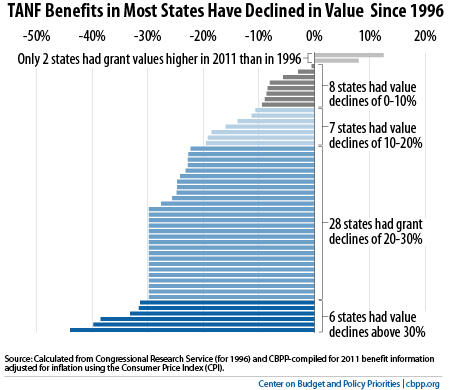The Great Recession has exposed both the strengths and weaknesses of our nation’s safety net. The Supplemental Nutrition Program (SNAP, formerly food stamps) and Medicaid have shown that safety-net programs can, if designed properly, push back against increased hardship during a downturn by responding automatically to sharp and sudden increases in need.
Unfortunately, the same cannot be said of Temporary Assistance for Needy Families (TANF), which provides cash assistance to low-income families with children who have nowhere else to turn for help.
TANF’s effectiveness as a safety net depends both on the extent to which very poor families are enrolled in it and on the level of benefits that they receive. TANF has been performing inadequately in both areas for some time, but the situation has worsened during the downturn:
- Few very needy families receive TANF benefits. In 1996, for every 100 poor families with children, 68 received cash assistance through the Aid to Families with Dependent Children program, which TANF replaced. In 2009, for every 100 such families in poverty, only 27 received cash assistance through TANF. Between December 2007 and December 2009, state TANF caseloads increased by just 13 percent nationally, lagging far behind the increases in SNAP caseloads, the number of unemployed, and the number of people in families with children that live below the poverty line.
- TANF benefit levels are low and falling. Cash assistance benefits have fallen by 20 percent or more in 34 states since 1996, after adjusting for inflation (see chart). In the median state, a family of three receives just $428 per month. The majority of states now provide TANF benefits that are below 30 percent of the poverty line.
Worse, six states and the District of Columbia have cut their TANF benefit levels since August 2010, our new report shows, reducing assistance for more than 700,000 low-income families that represent over one-third of all low-income families receiving such assistance nationwide.
TANF benefits thus are increasingly inadequate to help poor families meet basic needs, like housing. In every state, the monthly TANF benefit level for a family of three is less than the estimated cost of a modest two-bedroom apartment.
The much-touted 1996 bipartisan welfare reform deal, which created TANF, sought a balanced approach: to require able-bodied recipients to work or prepare for work while maintaining a safety net for parents who were unable to work due to a short-term crisis, a work-limiting disability, or the lack of available jobs. (Many of the families that receive assistance include a disabled household member and most have limited job skills, which makes finding a job in a weak economy that much harder.) Unfortunately, the program’s safety-net aspect is getting weaker with every passing year.
Related Posts:

